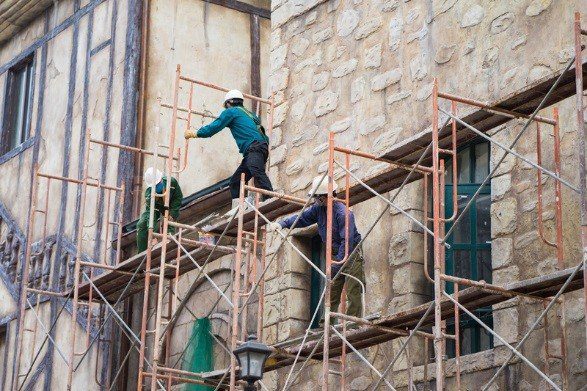Scaffolding…what’s that?
A scaffold is an elevated temporary work surface that supports employees or materials.
What are the different types?
Suspended Scaffolds: A plaform suspended from overhead.
Supported Scaffolds: One or more platforms supported by poles, legs, frames, outriggers, etc.
Scissor Lifts/Aerial Lifts: Platforms that are mobilized and easily move.

Who you gonna call?
Not ghostbusters this time! You need two experts before you erect any scaffolding: a qualified person and a competent person.
Qualified Person
Prior to assembly, a qualified person must design the scaffold and set the specifications for using it. A qualified person has the right background such as education, degree, certification or professional standing that shows they are an expert in designing safe scaffolding. In other words—they know all there is to know about scaffolds! This person might work for the scaffold manufacturer or, in special cases, might be assigned to a job where the normal scaffold just won’t get the job done—like if you’re working on the Statue of Liberty.
Competent Person
A competent person selects the appropriate scaffold for the task, supervises the assembly of the scaffold system and inspects each component. He must also understand, recognize, control and eliminate any hazards, such as access issues, possible instability and collapse during assembly/disassembly, electrical hazards, and fall and struck-by hazards. OSHA says a competent person must also have the authority to take prompt corrective measures to eliminate such hazards.
Before each shift (and sometimes more often), a competent person inspects the scaffold for defects. He should keep an eye out for fully planked platforms, proper guardrail height, crossbracing, midrails, stable footing, guying and proper access. Whew—that’s a lot to keep track of! Good thing your competent person has training too!
Not only does the competent person need to know how to erect, move, inspect and maintain the scaffold, he needs to make sure that employees are working safely while on the scaffold. This person should be identified on company letterhead for each site, along with his qualifications and authority to correct hazards.
What about the workers using the scaffold?
Mainly, they need some training! Employees who assemble and remove scaffolds must be trained by a trainer with knowledge and experience and supervised by a competent person. Sometimes that’s the same person and sometimes it’s not. A third-party expert can complete the training, if need be.
Can I get a recap?
- There are three types of scaffolds—supported scaffolds, suspended scaffolds, and aerial lifts.
- Two primary groups of employees work with supported scaffolds—Erectors/Dismantlers and Users.
- A qualified person is the academic person with the background to make them an expert in the structures of scaffolding.
- A competent person oversees the training of employees that build/remove and use the scaffold. He inspects the scaffold before each work shift and has the authority to take corrective actions if needed.
